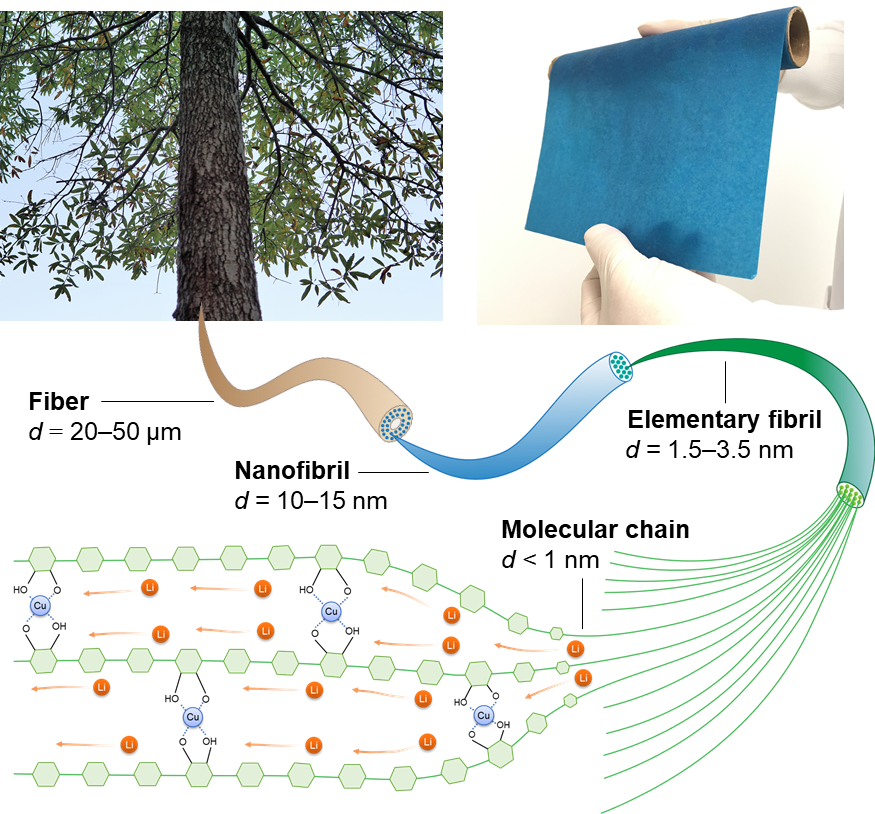Press Release
Expanded Wood Fiber for High-Performance Solid-State Paper Batteries
UMD research group invented the first high-performance solid-state paper batteries by a new molecular scale engineering method.
FOR IMMEDIATE RELEASE October 21, 2021
CONTACT:
Katie Holland
301 405 0379
khollan3@umd.edu

High-performance solid-state Li-ion conductor enabled by using natural abundant cellulose and opening cellulose molecular channels.
Reported in Nature on October 20, a team has put a new spin on ion conductors, which are critical for solid-state batteries. The team arranged copper (Cu) ions with cellulose nano-fibrils (CNFs) – tiny, thread-like tubes, mechanically derived from trees – to open the molecular channels for smoother, more efficient ion conduction.
The team, led by Liangbing Hu - a Herbert Rabin Distinguished Professor in the University of Maryland (UMD) Department of Materials Science and Engineering (MSE) and the founding director of Center for Materials Innovation (CMI) – soaked CNFs in a copper-alkaline solution to enable Cu-CNF coordination. They then inserted lithium ions to the material by soaking it in an electrolyte, which produced a Li-Cu-CNF ion conductor.
"By incorporating copper with one-dimensional cellulose nanofibrils, we demonstrated that the opening of molecular channels within the normally ion-insulating cellulose offers a speedier lithium-ion transport within the polymer chains," said Hu. "In fact, we found this ion conductor achieved a record high ionic conductivity among all solid polymer electrolytes, 10-100 times higher than other polymer electrolytes."
In addition to the high conductivity, this Li-Cu-CNF electrolyte offers high transference number and a wide electrochemical stability window (up to 4.5 volts), and can be applied to lithium-metal anodes and high-voltage cathodes.
It's easy to assemble, inexpensive and scalable, depending on the size of the battery. Moreover, the material is strong, flexible and eco-friendly.
"Using materials nature provides will reduce the overall impact of battery manufacture to our environment," said Yue Qi, Joan Wernig Sorensen Professor of Engineering at Brown University. "Understanding the process-structure-property relationship is the central theme for materials science research. We used molecular dynamics to track the processing conditions, predict the atomistic structures that are hard to capture by experiments, and sort out the transport mechanisms."
Perhaps more astounding, this molecular scale engineering method provides a general strategy to design solid-state ion conductors, which are applicable in areas beyond batteries, such as electrochemical synaptic devices, solid-state sensors, and redox-controlled information processing and storage.
This study was a collaborative effort between researchers at the University of Maryland, Army Research Laboratory, University of Münster, University of Tokyo, CUNY, Florida State University, University of Delaware and the National Institute of Standards and Technology.
For additional information:
Yang, C., et al. (20October2021). “Copper-coordinated cellulose ion conductors for solid-state batteries.” Nature, DOI: 10.1038/s41586-021-03885-6
About the A. James Clark School of Engineering
The University of Maryland’s A. James Clark School of Engineering is a premier program, ranked among the top 20 in the world. Located just a few miles from Washington, D.C., the Clark School is at the center of a constellation of high-tech companies and federal laboratories, offering students and faculty access to unique professional opportunities.
Our broad spectrum of academic programs, including the world’s only accredited undergraduate fire protection engineering program, is complemented by a vibrant entrepreneurial ecosystem, early hands-on educational experiences, and participation in national and international competitions.
The Clark School is leading research advancements in aerospace, bioengineering, robotics, nanotechnology, disaster resilience, energy and sustainability, and cybersecurity. From the universal product code to satellite radio, SMS text messaging to the implantable insulin pump, our students, faculty, and alumni are engineering life-changing innovations for millions. Learn more at www.eng.umd.edu.